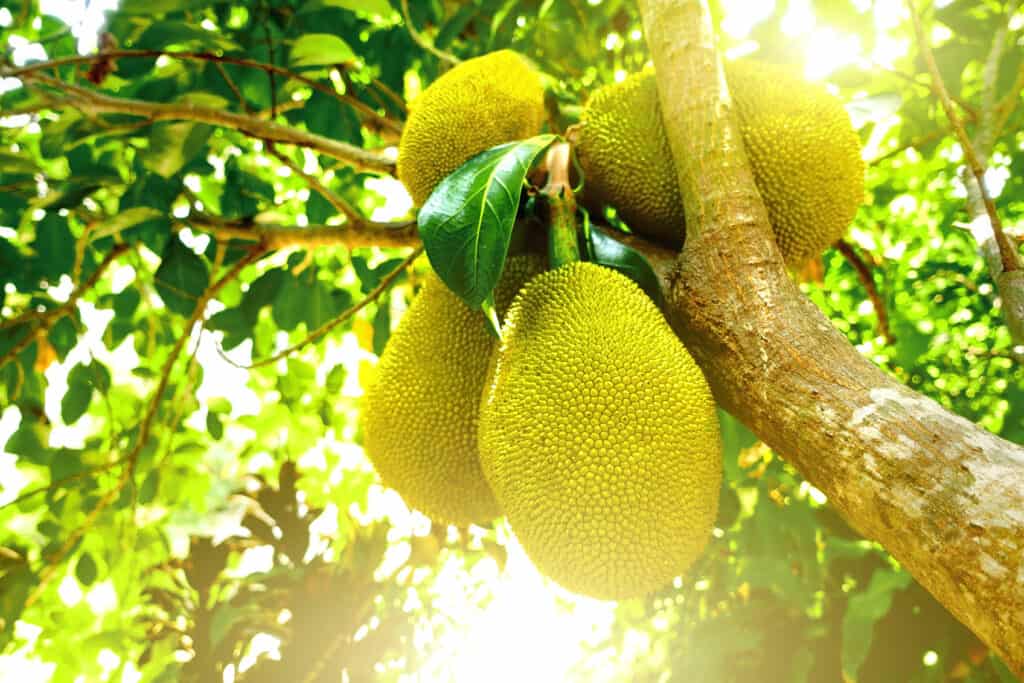Many people believe soursop and jackfruit are related because of their similar looks. Both of these unique fruits share an ovaline shape and green to yellow spiny shell. Despite the similarities in appearance, soursop and jackfruit are completely different. They come from different parts of the world, have distinct flavors, and have contrasting culinary applications. So, soursop vs. jackfruit: here are the notable differences between them and how you can enjoy each.

Comparing Soursop vs. Jackfruit
| Soursop | Jackfruit | |
|---|---|---|
| Classification | Annona muricata | Artocarpus heterophyllus |
| Alternative Names | Guyabano, Brazilian paw paw, Custard apple, Graviola | Jacktree, Jaca, Kathal, Nangka, Chakka pazham |
| Origin | The Caribbean, Central America | Asia |
| Description | The jackfruit tree grows from 35-65 feet tall, spanning 20-50 feet. The bark is reddish-brown and smooth. Leaves are deep green, waxy, and elliptical, growing up to 8 inches long. Blooms and fruit are light yellow-green. The jackfruit has a rough, pebbled exterior and a white, meaty interior. Fruit can grow up to 35 inches long and 100 lbs. | Soursop’s texture is creamy, like a banana, and often compared to yogurt. |
| Uses | Soursop is primarily used for culinary purposes and is a common ingredient in ice creams, desserts, and smoothies. | Jackfruit is used in traditional medicine as a salve for injuries. Its modern use is culinary as a popular plant-based substitution for meat. |
| Growth Tips | This tropical tree grows in USDA Zones 9-11 and won’t resist cold climates. Soursop will grow indoors in full sun and well-draining soil. This low-maintenance plant will grow as a potted indoor tree. | This tropical tree grows in USDA Zones 10-12 and won’t resist cold climates. Jackfruit will grow from seed indoors in full sun and well-draining soil with plenty of room for root spread but often die within a few years. |
| Interesting Features | Soursop’s texture is creamy like a banana, and often compared to yogurt. | Jackfruit is the largest fruit to grow on trees. |
| Flavor Profile | Fruity, sweet, tangy | Sweet, meaty, mild |
What Are the Key Differences Between Soursop and Jackfruit?
Beyond the visual similarities, soursop and jackfruit are entirely different. The first difference becomes apparent when looking at both fruits together. Soursop is significantly smaller than jackfruit!
While the coloration of soursop and jackfruit are similar, the textures could not be less alike. Soursop features a creamy texture reminiscent of yogurt or a banana, while jackfruit offers a stringy, meaty consistency. Soursop delights with a sweet flavor, while many compare jackfruit’s taste to pork.
These distinct tastes and textures lead to varied culinary uses. While people use jackfruit as an excellent meat alternative for those on plant-based diets, chefs commonly incorporate soursop into sweet recipes, smoothies, and desserts.
Soursop vs. Jackfruit: Classification
Soursop is classified as Annona muricata. The Annona genus is home to several tropical trees and shrubs, many of which are edible. Soursop is a member of the Magnoliales order — a relative of magnolia flowers.
Jackfruit is classified as Artocarpus heterophyllus. The Artocarpus genus is home to trees and shrubs in Pacific South Asia. Jackfruit is closely related to mulberries and figs and is a member of the order Rosales — the rose family.
In essence, soursop and jackfruit plants are unrelated.

As a tropical plant, soursop is native to Central America.
©iStock.com/Photographer
Soursop vs. Jackfruit: Origin
Soursop is native to the Caribbean and Central America. There are incidents of soursop growing in India and the surrounding parts of Asia as a transplanted tree that has become invasive.
Jackfruit is from Southern Asia, though it’s now grown and cultivated in tropical regions around the world.
Soursop vs. Jackfruit: Description
Jackfruit trees (and the attached fruit) can grow to extraordinary sizes. The jackfruit tree can reach 65 feet tall and 50 feet wide, with fruit growing to 2-3 feet long and weighing up to 100 lbs each. The bark is reddish-brown and smooth. The leaves are deep green, long, and shiny. The blooms and fruit are a similar light yellow-green shade. The jackfruit has a rough, scaly exterior similar to spines or small pebbles. The interior is a creamy white with a stringy, meat-like texture.
The soursop tree can reach 30 feet and is 8-10 feet wide. The bark is deep brown and smooth, though it’s occasionally ridged in texture depending on its environment. The leaves are lanceolate (elongated with sharp, pointy ends) with a deep green color and waxy sheen. Soursop blossoms are a stunning bright yellow. The soursop has a green, spiny exterior and a white, creamy interior. The fruit can grow up to 10 inches long and 13 lbs.

Jackfruit can weigh up to 100 lbs.
©ChockdeePermploysiri/Shutterstock.com
Soursop vs. Jackfruit: Uses
Soursop is a delicious, hydrating fruit with a high content of vitamin C and water. The creamy texture makes it ideal for smoothies and fruit bowls.
Jackfruit has become popular in recent years due to its meat-like texture. It’s a great meat alternative for dishes like pulled pork or tacos. The mild, sweet flavor tends to pick up the spices or sauces used in cooking. This hydrating fruit is high in vitamin B6 and fiber, with moderate potassium and vitamin C levels.
Soursop vs. Jackfruit: Growth Tips
Unless you live in a tropical climate, growing soursop or jackfruit outdoors isn’t an option. Soursop can be grown indoors as an ornamental tree but will likely never bear fruit. Jackfruit trees don’t grow well indoors and often die within a few seasons after sprouting. Both plants prefer full sun and well-draining soil.
The photo featured at the top of this post is © ChockdeePermploysiri/Shutterstock.com
Thank you for reading! Have some feedback for us? Contact the AZ Animals editorial team.






